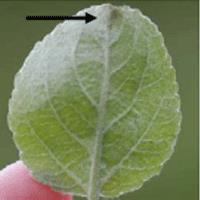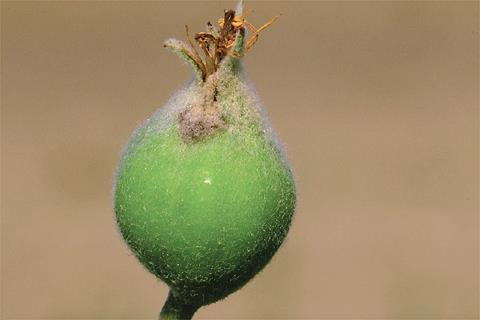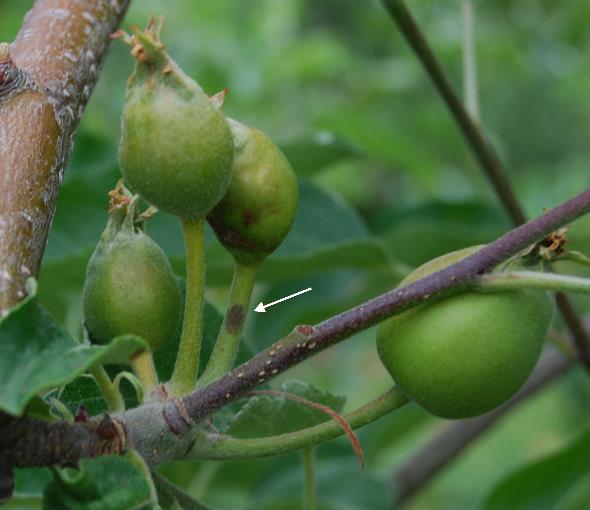Scab, Frost… Now What?
We are at that point where it will soon be clear how effective apple growers’ early-season scab management programs were. Your program from here on out will depend on whether or not you see scab lesions and how much crop loss you expect from the recent frost events.

Scouting for early-season scab. The “rules” are that primary scab lesions show up most frequently on cluster leaves and the undersides of leaves, especially at the margins, because these are the parts that are first exposed when buds break (see photo at right). On young fruit, lesions often are clustered closer to the blossom end, and sometimes appear on pedicels (see photos below). There are of course exceptions to the rules, so don’t count out the upper surfaces of leaves, and keep in mind that at this point in the season, some lesions we are seeing are likely from secondary infections, which tend to be located anywhere on leaves and fruit.
Frost! A complicating factor this year is that the significant frost event a couple of weeks ago might have injured infected tissues, so rather than appearing soft and fuzzy with scab spores, lesions are dark and crunchy. Does this mean all early-season scab froze to death? Don’t count on it – scab is not that stupid. During the freeze there were other infections just getting started. They were likely put on hold, but once things warmed up, lesion development resumed.
Why scab control fails. Apple scab is a manageable disease, but it does generally require spraying scab-susceptible varieties at the right time with the right fungicides. The following factors, alone or in combination, lead to apple scab control failures:
- Not spraying early enough. Apple leaves are susceptible to scab infection as soon as green tissue emerges. Infections that happen at green tip or up to half-inch green can produce secondary spores by the time of bloom. Fruit is highly susceptible at bloom and a few weeks thereafter. An individual leaf of a susceptible variety remains susceptible until about 17 days after unfurling.
- Using the wrong products at the wrong time. There are a lot of fungicides that are highly effective on scab, but you need to know their relative strengths and weaknesses to develop an optimal spray program. The broad-spectrum contact fungicides, such as captan and mancozeb, are good products to use on emerging leaves up until about the pink bud stage. Copper is an excellent scab fungicide, but the risk of injury to fruit increases if applied later than about the tight cluster stage. These contact, protectant fungicides are tenacious and will redistribute during rain and in dew to cover new growth. But at pink-bud and during bloom, which is the time of peak scab susceptibility of the plant, and peak spore release in the scab fungus, scab control is enhanced by using fungicides with some post-infection activity, notably the sterol demethylation inhibitors (SIs), strobilurins, and succinate dehydrogenase inhibitors (SDHIs). See the 2016 Midwest Fruit Pest Management Guide for more details on fungicides.
- Using rates that are too low and/or spraying at intervals that are too long. When shoots are rapidly elongating, and leaves rapidly expanding, contact fungicides need to redistribute in dew or rain to cover new growth. In doing so, they become diluted. Captan redistributes well, but it doesn’t last as long as mancozeb. Mancozeb is durable, but it doesn’t redistribute as well. Systemic fungicides become diluted internally as leaves expand. So if you start with a low rate, the amount of fungicide available on the surface or inside leaves will only go down. Likewise, heavy rainfall will remove some residues.
- Asking too much of the post-infection properties of fungicides. When the SI fungicides were new in the early 1990s, you could eradicate scab by spraying 4-days after infection took place. After many years of use, however, the scab fungus is developing resistance. While this has been formally tested for only a small handful of Wisconsin orchards, at many more sites there is strong circumstantial evidence that the SIs are not as potent as they once were. In most cases the SI fungicides will still inhibit scab, especially if higher rates are used, but they will not eradicate an infection. And their “kickback” potential to inhibit the fungus after infection has been reduced from 4-days to no more than 1- or 2-days post-infection.
- Poor coverage. Too low volume, poorly calibrated sprayer, driving too fast, spraying in windy conditions, alternate-row spraying… it’s no secret what leads to poor coverage.
- High levels of scab the previous fall. Apple scab overwinters on leaves on the orchard floor. However, there is much evidence and some research that following mild winters, scab can also overwinter underneath bud scales. This probably happens only when scab is very severe in fall, but late-season scab is very common and, in my opinion, underappreciated. The cool, sometimes wet weather of September and October, combined with increased susceptibility in aging leaves can lead to very high levels of scab, especially on the undersides of leaves, even in orchards where the fruit was clean. Not really much you can do about it that late in the season, except possibly shredding leaves to hasten their decomposition. But, if you are aware of it in fall, you can be extra diligent the following spring.
What to do if you see scab now? First question—how much loss do you expect from frost? If you do not expect to harvest a crop, then spray programs can be cut back and cheaper products can be used, but some level of control will probably be needed to avoid a late-season season epidemic (see #6 above). Dave Rosenberger, now retired from the Cornell Hudson Valley research station, wrote a good article on disease management in frost-damaged orchards in 2012. See Scaffolds Fruit Journal Volume 21, No. 8.
You might have some trees whose crop is a loss, whereas others you are counting on for a decent harvest. Obviously, you don’t want scab running rampant on the “lost cause” trees, but keep in mind that secondary scab spreads mostly within a tree canopy. That is, most spores don’t blow very far. So a little scab in the lost cause trees won’t sabotage scab control in other trees. That said, the more spores you have in the lost cause trees, then the greater the risk of some escaping into nearby “good” trees.
Controlling a scab epidemic in June is two-pronged. First, you need to protect fruit, because they remain quite susceptible until a waxy cuticle develops. Second, you want to shut down sporulating lesions. For conventional growers, fruit are protected best by higher rates of captan. As mentioned previously, it redistributes well on leaf and fruit surfaces. For more information on the pros and cons of captan, I refer you to another Rosenberger Scaffolds article Volume 22, No. 12.
Shutting down sporulating scab lesions is not cheap. One option is to mix dodine (most common brand is Syllit) with a high rate of captan. Dodine is an excellent anti-sporulant, unless the scab fungus has developed resistance to it. Unfortunately, there is no easy way to tell beforehand if you have resistance. Many growers in Wisconsin, however, have told me that they get good results, even though it was used extensively in their orchards in the 1970s and 1980s, before the SIs came along. However, recognizing its value for scab “bail out,” they reserve it only for such emergencies. Another approach is to use high rates of both captan and an SI fungicide. This approach would only work where the scab population has not become notably resistant to SI fungicides. Hot, sunny days are scab’s worst nightmare, and there is some evidence that captan acts synergistically with hot temperatures in shutting down scab lesions. Fortunately, by the time trees set terminal buds (late June/early July), leaves are fairly resistant to further infection, at least until they start ageing in late summer.
What to do if the orchard is clean? You’re not out of the woods yet! On susceptible varieties, it would be risky to cut off protectant fungicides (e.g., captan, strobilurins) until middle to late June. First, early lesions may still be lurking out there, but are not yet obvious. Second, fruit is still really susceptible, and as long as new leaves are emerging, they too are susceptible. But if lesions are not visible on leaves by middle to late June, then there will be no source of spores and the risk of scab diminishes. You might need to consider captan and/or strobilurin fungicides for summer disease control, but the risk of scab has past.
This article was posted in Apples, Disease and tagged Apple Scab, Apples, frost, frost damage, Patty McManus.


